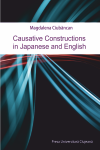| SUMMARY: |
Causative constructions have been one of the most investigated linguistic phenomena over the last forty years. Their complexity, both in regard to their semantic characteristics and to their syntactic structure, has posed numerous problems, many of which stIll constitute the ground for heated debates among linguists from various theoretical backgrounds. The major goal of this work is to offer a comprehensive view on causative constructions in Japanese and English by analyzing them both from a syntactic and from a semantic perspective. Causative construction are defined here as the linguistic expression of causation, understood as the production of an effect by a cause and are clearly distinguished from another notion widely used in reference to the cause-effect relation, namely causality, understood as the relation between cause and effect. From a semantic perspective, Japanese and English causatives are treated in view of the elements composing the causative situation – the causer/causing event, the causee and the result. In regard to the causing event, the author analyzes the various underlying semantic predicates that can be postulated in order to capture the nuances of the causing process. |
|
